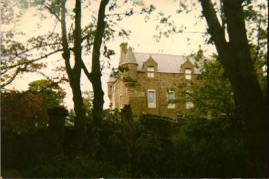The Raits of Hallgreen Castle
The Family Details
This history begins with Sir Alexander de Rait (or de Rathe), of Rait Castle near Nairn, who, tradition says, in about 1405 murdered Andrew, the 4th Thane of Cawdor, by the water dam of Raite and was forced to flee to the protection of the Keiths (the family later to become Earl Marischal of Scotland) who were based in Dunnottar Castle, a few miles to the north of Hallgreen Castle in Kincardineshire. Presumably Alexander brought all the members of his family with him because there were no records of Raits (or Rathes) in the Province of Moray for a long time afterwards. However, he may have had relatives in Kincardineshire, since there were Raitts there before he arrived (notably Thomas Rait/de Rathe, the King's Shield Bearer. in the late 14th century.)
We have no knowledge of Sir Alexander other than this one act of violence and its consequence, but we do know about his two sons. Mark was probably the older son, and what we know about him is detailed below. John was probably the younger son, who, in 1440, acquired (by charter) the lands of Drumtochty and half of Campsie in Kincardineshire. John's wife is not known, but he had two children by her, Henry, who, by 1450, had received from his father a charter for the west half of Drumtochty, and Elizabeth, who married Alexander Calder and, also by 1450, had given a charter on Drumtochty lands to her husband (these charters were presumably recorded in the local register of sasines). Their descendants are not known.
Mark Rait, the first Rait Laird of Hallgreen appears to have purchased the lands of Drumnager (or Drumnagair) located just south-west of Laurencekirk in Kincardineshire. He married the daughter and heiress of Dunnet of Hallgreen, and, through her, in 1425 he inherited Hallgreen Castle, which had been built in 1376. No other information is available about the Dunnets. Mark had no children with her, and she presumably died shortly afterwards, because he then married a daughter of Ogilvie of that Ilk with whom he had a son, David.
The lands of Drumnagair remained in the hands of the family until at least late in the 17th century, initially as the inheritance of the eldest son of the laird, and later of a younger son. However, a legal document of 1693 mentions a "Barony of Drumnagair" comprising part of Silliflett near Inverbervie, part of Gourdon, lands of Aberluthnott, of Hallgreen, and "others in the sheriffdom of Kincardine", so the property referred to in later inheritances may have been more extensive than the actual farm now carrying that name.
David Rait, the second Laird was described in 1471 as "of Drumnagair" in a document giving him rights to lands in Inverbervie. He married Katrine, a daughter of Murray of Tullibardine, and died before 1514. His only known child was William, his successor as Laird of Hallgreen.
William Rait, the third Laird was also described, in 1504, as "of Drumnager", in a Sheriff Court dispute over rights in Inverbervie. By 1490 he was married to one of the seven daughters of Arbuthnott of that Ilk, and later was married to a daughter of Sir Alexander Stratton of that Ilk. William is said to have been the Captain of the King's Guard for King James IV of Scotland, and therefore presumably perished with the King and his supporters at the battle of Flodden, Northumberland in 1513. In 1514, he was "discharged as franktenementar of Drumnagar" in a legal document which appears to be confirmation of his death. He had two sons, David who succeeded him, and James, a bailie possibly of Inverbervie, though we know no more about him.
David Rait, the fourth Laird is recorded as "of Drumnagar" from 1526-1546, and in 1549 he becomes "of Drumnagar and Hallgreen". Does this mean that his father survived until then, rather than having been killed at Flodden? David married Isobel, daughter of Garden of Brackills, with whom he had four sons, and then he married a daughter of an Ogilvy family. David died by 1553/4.
Their oldest son, William, succeeded to Hallgreen as fifth laird (see below).
Robert (also known as Rayt), possibly his second son, was described in a 1518 Perthshire sasine as "chaplain", and his seal on a charter of 1541/2 is described as a "cross engrailed with a star in sinister chief". He was married to Katherine Lindsay, who outlived him, and they had one son - also named Robert - who, in 1553, made a claim on Silliflett (see below.)
In 1553/4 David's other two sons, John and Thomas, shared the farm called Silliflett located next to the Hallgreen Castle estate. We know nothing more about Thomas, who was apparently the younger of the two as they appear in that order in a Court document of 1553/4. John, who had rights to a property in Gourdon in 1549, was still in Silliflett in 1593. He was married to Elizabeth Straton and the father of the Rev David Rait who became the Principal of King's College in Aberdeen from 1592-1632 (when he died), having already filled the posts of humanist, regent and sub-principal from 1580-1592. He was given the degree of Doctor of Divinity in 1620. He had rights to properties in Inverbervie as well as in Aberdeenshire. In 1592 he married Elizabeth, daughter of John Allardice of that Ilk, and with her had five sons. Andrew is included with his father in sasines on properties in Aberdeenshire from 1622 to 1632, and on 17 December 1636 was served heir (as Andrew Raitt) to his father in the lands of Over and Nether Balmakewan, a property near Marykirk in Kincardineshire including Drumhendry near Edzell, Angus. (Later, at an unknown date a Col. Robert Rait was the heritor of Drumhendry - this may be Andrew’s brother). Their son William married Jean Leith, and is included with his father in Aberdeenshire sasines from 1622-1632 when he was "of Balmakewnis", and in 1642 when he was "in Old Aberdeen". Another son, James, was an apprentice litster (dyer) in 1642. The other two sons were Robert and John.
William Rait, the fifth Laird. Tradition says that he died at the Battle of Pinkie, near Musselburgh, Midlothian in 1547 (he was certainly dead by 1561). He married first a daughter of Lundie of Benholm, and then Agnes Gray.
At this point, the succession to the lairdship of Hallgreen becomes very complicated. The Scottish naming system, adhered to by the Hallgreen Raits through the 15th and 16th centuries, whereby the eldest son and heir receives his paternal grandfather's forename, suggests that the next laird should have been a David Rait. As there is no evidence of one such, it is possible that he died at an early stage, possibly accompanying his father at Pinkie.
A petition of unknown date supported by William, the fifth laird, and his brother John, as servitors (executors?) of their father David's will, gives the succession to David's “nephew” William, which was then claimed by that William in 1557. It is not known if David's only known brother James had a son called William. Although the petition uses the word ”nevoy”, or nephew, to describe William, it is surely probable that the word “oy”, or grandson, was intended, making William the sixth laird the (second) son of William the fifth laird and younger brother of the hypothetical David, and for the convenience of telling the story of the Hallgreen Raits I will assume that the latter is correct.
The fifth laird's second (or third) son John (called “John the elder” in legal documents) was a bailie in Inverbervie in 1561, and had sasine on lands in Inverbervie from his mother, Agnes Gray (who re-married, to Gilbert Law of Grayshill, after William died). John died by 1606, having had two sons, John (called “the younger”) who, in 1580, was living in Grayshill, Inverbervie, and Robert who, in 1606, lived in Montrose, and, having been made heir to his father in 1606 in all his lands in Inverbervie, in 1607 resigned these rights to Andrew Rait, the bailie (possibly his cousin, mentioned below.)
William Rait, the sixth Laird. In 1557 he petitioned the Lords of Council for his recognition (by delivering the relevant charters to him) as the heir to the deceased David Rait of Drumnagar (probably his grandfather). This implies that William, the fifth Laird, was already dead by that date, but William the sixth was still suing John of Silliflett in 1569/70 for payments due from Drumnagar, and he did not obtain a charter to the lands of Drumnagar until 1574. Clearly the inheritance was not straightforward.
This William also extended the property interests of Hallgreen into the county of Forfarshire (Angus) by obtaining, in 1597, a charter for the whole of Cononsyth in the parish of Carmyllie, Forfarshire, from the Gardynes. He still held that property in 1603, when he sold Pressock in the barony of Gardyne in Forfarshire. By 1574 he was married to Margaret, daughter of Garden (or Gardyne) of Leys, and in 1578 he was married to Marjorie, daughter of Barclay of Mathers. William had at least six children, but, in the absence of birth records, there is no indication of which wife was the mother. As William Rait of Halgrein he was signatory, with others, to a band acknowledging Prince James the sixth, King of Scots, as their only sovereign lord, subscribed at Edinburgh, St Andrews, Aberdeen and Inverness on 21st, 26th Ap., 7th, 9th May, 4th, 5th, 6th, 9th June, and 9th July. He presumably subscribed one one of the days in June in Aberdeen. He died before 1625.
David, the eldest son, succeeded as the seventh Laird.
Robert was "the second son". From 1582-1593 his father administered on his behalf the sunny side of Garlott, leased from Lord Ogilvie. In 1591/2 Robert bought Pressock in the barony of Gardyne from Garden of that Ilk to be shared with his wife as part of their marriage contract. In 1597 he had rights to two-ninths of Inverbervie known as "freris Syllisflet", and in 1597 shared a charter for Cononsyth with his father. In 1591 he had a marriage contract with Margaret Ross, who by 1606 was re-married to a Robert Fraser, suggesting that Robert Rait had died by then. They had at least two, probably three, children, and theirs is the story of the Raits of Cononsyth which is related separately (see also under Raitts in the 1841 census).
The third son may have been the Andrew Rait, who from 1604-1611 was a bailie in Inverbervie and had sasine on lands there. He was dead by 1612, and his daughter Helen had the Rev. Principal David Rait, served as her heir in the lands of Mill of Craigie.
The fourth son of the sixth Laird was the Rev. James. Born in about 1583 (and therefore presumably the son of Marjorie Barclay), he was a Regent in King's College, Aberdeen in 1610, before being inducted to the ministry in 1617 in the parish of Aberluthnott (Marykirk). In 1626 he was given, and almost immediately renounced, sasine on the Mains of Drumnagar by his nephew, the seventh Laird, but in 1637 accepted from him rights to lands in Aberluthnott. He was married to Isabella Blackburn, daughter of the Bishop of Aberdeen, and the younger sister of Janet who married the Rev. Archibald Rait. Both Archibald and James studied at King's College at a time when their relative, Principal David Rait, may have introduced them to the Bishop's daughters. James died in 1642, and he and his wife are commemorated on a tablet in Aberluthnott Church where he had preached for 25 years. They had one son, William, who started the dynasty of the Raits of Pitforthie.
At about this time there was a Rev. Archibald, minister of Kintore, Aberdeenshire, from 1602 to 1624, who was said to be a cadet of the Hallgreen family, and who may have been a son of William, the sixth laird. He married Janet, the daughter of Bishop Peter Blackburn of Aberdeen, and various records suggest that he benefited from a relationship with the Bishop and with his probably close relative, Principal David Rait of King's College in Aberdeen. He was the progenitor of the large family of Raits in Fyvie and Rayne parishes in Aberdeenshire, which will be the subject of a separate account.
The daughters of the sixth Laird of Hallgreen were Marjorie (or Margaret) who in 1600 married Alexander Chalmers of Cults, Aberdeenshire, and had a son, also Alexexander Chalmers; Elizabeth who married David Arbuthnott of Findowie in Angus (she died in 1593 or December 1595 and her husband in 1602) and had four daughters and a son Robert Arbuthnott (married to Margaret Graham, daughter of Sir William Graham of Claverhouse), who himself had a son called Robert Arbuthnott who married on 9 Nov 1641 Elizabeth, eldest daughter of William Rait, the eighth Laird of Hallgreen, (they had six boys and six girls); and Catherine who, from 1582-1593, had rights to the shadow half-lands of Garlott with her father as administrator on her behalf.
David Rait, the seventh Laird. The records of this laird are rather confusing, and it is possible that two contemporaneous Davids have been merged. In 1583, when one of his servants was murdered, he was "of Drumnagar", and in 1596, still in Drumnager, he was Sheriff of Kincardine. In 1611, David, as fiar of Hallgreen, appears with William Rait of Hallgreen in a legal document, in 1612 he was heir apparent of Hallgreen, and in 1616 he was Laird of Ballandrow, a property which passed to his son, William, by 1620. In other documents, dated 1621 and 1622, David, fiar of Hallgreen, is specifically called the son of William of Hallgreen. David's father, William, was still alive in 1622, and David is called "of Hallgreen" in 1625 and 1628. His son William had taken over between 1633 and 1637.
David had three wives, apparently two at the same time – or, more probably there were two David Raits and it has not been able to distinguish between them. In 1596 there is a record of a Catherine “sometime spouse” i.e. deceased, and in 1595, while he was still "apparent heir" to Hallgreen, there was a marriage contract to Elizabeth, daughter of Stratton of Lowrenstoun (Laurencekirk?) in which she was to get rights to Drumnagair, and she was supposed to have married him in 1605. However, in 1604, there was a marriage contract between David, "fiar of Hallgreen" and Margaret Graham, widow of James Straithauchin, apparent heir of Monboddo. Whichever wife is correct, David had six children.
William, the eldest, succeeded as the eighth Laird.
Elizabeth, probably his eldest daughter, was married in 1612 to Robert, eldest son of John
Lumsden of Cushny, Aberdeenshire, and was given rights to rents from lands in the barony of Cushny. They had no children.
Andrew, "the lawful son of the laird of Hallgreen", and from the parish of Kinneff in Kincardineshire, was married in 1639 in the parish of Belhelvie, Aberdeenshire, to Marjorie Seaton, the sister of William Seaton of Menie in Belhelvie. In 1656 he was given title-deeds for Cocklaw, near Peterhead, Aberdeenshire, part of which he passed to his wife. He died before 1679, and the following year, his wife disposed of all her possessions to James Rait, her husband's grand-nephew who appears to have acted as the family solicitor at that time. Andrew and Marjorie presumably had no children as heirs.
Isobel is mentioned in legal letters of 1657 as the sister of William Rait of Hallgreen; Jean had an antenuptial contract in 1625 for marriage with Robert, eldest son of Andrew Arbuthnott of Little Fiddes, Kincardineshire; and Euphame had an antenuptial contract dated 1628 with William Napier of Blacklaws, Kinneff parish, who was a bailie in Inverbervie.
William Rait, the eighth Laird. As the "eldest son" of David, the seventh Laird, William was given the lands of Ballandro in the parish of Benholm in 1620. In 1621 he was given lands at the Kirktoun of Aberluthnott, and between 1626 and 1633 the lands of Drumnagar from his uncle, the Rev. James Rait, minister of Aberluthnott. By 1637 he was the Laird of Hallgreen itself, and was married by 1620 to Jean, sister of Sir William Douglas of Glenbervie, with whom he had at least eight, probably nine children. As his successors were also called William, it is not apparent when he died. He seems to have been married a second time – to Elizabeth, daughter of Sir G. Auchinleck of Balmanno.
William, the eldest son, became the ninth Laird.
Robert was a resident of Montrose from at least as early as 1658, and was Provost in 1673, at which time he was a resident "of Snadoune" (presumably Snaden, lying north of Montrose). In 1676, as "of Snatoun" and former provost of Montrose, he became a burgess of Aberdeen. At a much earlier date he married Jean Scot, and they had a son Robert who, in 1658, was resident in Paris.
The Rev. James was born in about 1612, graduated from King's College in 1632, and was admitted to the ministry of Dunottar parish before 1654. In 1665 he married Elizabeth Allardes (who died in 1666 - possibly in childbirth), and then Jean Edmonston of Montrose. (These marriages may have been in reverse order, with James marrying Jean Edmonston (Irvine?) on 8 April 1660.) He died on 25 July 1676. In 1673 he owned rights to Findlaystoun (north-west of Stonehaven), shared about that time with David and Robert, the brothers of the Laird of Hallgreen (see below), and it is because of this sharing that it is believed the Rev. James must have been their uncle, and brother to the eighth Laird (although there is one item in which Robert writes to "his cousin" the Laird of Hallgreen, which suggests that he may have been the son of the Rev. James). The Rev. James had a son John who was served as his heir in Findlaystone in 1692, and who became a burgess of Aberdeen in 1695. He was still in Findlaystoun in 1711. John had a son Alexander, who, from at least 1728 to 1734 held various positions of authority on the staff of King's College, Aberdeen. The Rev. James may also have had a daughter, Helen, who married Andrew Honyman in 1702. Equally, she may have been his granddaughter.
The Rev. John was born in about 1623, and from 1640 to 1644 attended King's College, Aberdeen. In 1646 he was inducted to the ministry in Montrose, moving in 1650 to the parish of Inverkeilor, Forfarshire (Angus). From 1682 he was the proprietor of the nearby property of Brianton until his death in 1685. He and his family are commemorated by a large memorial in Inverkeilor Church and are also dealt with separately under the Raits of Inverkeilor.
His first wife was Elizabeth Beattie, with whom he had six children, five probably died in infancy, the sixth, John, died in 1675 in Nevis, West Indies, at the age of 22. She died in 1661, and in 1662 the Rev. John married Euphan Mudie of Brianton, the daughter of David Mudie and Janet Ramsay of Cairnton. They had five children. Robert and Janet died in infancy and are buried in Inverkeilor church. David inherited Brianton from his father, married Katherine Rait, daughter of the Rev. Robert Rait who was minister of Aberluthnott (Marykirk) from 1666-1682, and they had a son who became the laird of Brianton, but sold the estate in 1711. How this Rev. Robert fits in to the family tree is not yet known. However, he married Margaret Forbes in 1665 and besides Katherine, had three other children.
The Rev. James graduated from St Andrews in 1668 and was inducted to the church of Inverkeilor in 1672. A man of strong views, he was banned from preaching at Inverkeilor in 1695 and removed from the living in 1703. He moved to the nearby Redcastle (its last resident) and then to Montrose. In 1717 he was in further trouble "for rebellion". The 'History of the Mudie Family' claims that the Rev. James, son of the Rev. John, married his aunt Katherine Mudie, sister of Euphan. However, in 1710 he married Elizabeth Smith of Montrose with whom he had a daughter Margaret who married William Wallace, a Montrose bailie. The Rev. James died between 1720 and 1730.
The youngest of the Rev. John's children was the Rev. Francis who was inducted in Cuikston in Kinnaird parish, but ceased ministering before 1711 and was deposed for rebellion in 1717. In 1726 he was caught preaching in an illegal meeting-house in Brechin.
The Rev. Peter was born in about 1642, probably the youngest of William, the eighth laird's children. He graduated from King's College in 1663, and was admitted to Bervie parish in 1674, though he was deprived of the living in 1695. Between 1673 and 1686 he was writing letters to Hallgreen, "his nephew" (i.e. the tenth laird). He married Anna Innes (also record as Anne June), and had a son Robert, born 1689, and a daughter Mary. He died in 1698.
The other four children of the eighth laird were girls:
Elizabeth, the eldest daughter, married in 1641 Robert Arbuthnott, the son of Robert Arbuthnott and Margaret Graham, and grandson of David Arbuthnott and Elizabeth Rait, daughter of the sixth laird; Marjorie who was married in 1663 to William Ogilvy of Barras, and died in 1666; Anna who was married in 1653 in Bervie to Sir Francis Ogilvie, and was given a charter for Mains of Pitnamoon; and Margaret, who married Andrew Wood of Balbegno Castle, Fettercairn in 1660, and from 1681-1687 was writing letters from Balbegno to Hallgreen, her nephew. They had a son, Andrew Wood, who was married to The Hon. Catherine Arbuthnott before March 1686, and who sold Balbegno Castle in 1687.
William Rait, the ninth Laird. In 1646, he was given the lands of Ballandro in an antenuptial contract. His first wife was Magdalen Simmer with whom he had two children. Magdalen was baptized in Bervie in December 1641, and she married Robert Neaper in 1660. Alexander was baptized in January 1643: as his father later had another child called Alexander, and as his father's successor (the tenth laird) was his first child by his second wife, it is probable that the first Alexander died in infancy. It may be that Magdalen Simmer died early too (in childbirth, perhaps) because prior to 15 Dec 1646 William married Janet Arbuthnott, daughter of Sir Robert Arbuthnott of Arbuthnott. From 1647-1667 they had 18 children: there are records of 11 of them, and it may be that some died in infancy. William died in about 1670. In the National Records of Scotland collection, item RH15/37/117 has the title "A note of births and baptisms, 1647-1667, of 18 children of William Rait, younger of Halgreen, and Janet Arbuthnott, his spouse."
William, the eldest became the tenth Laird.
David, probably their second son, had rights to the Findlastoun property by 1667; in 1677 he was given Drumnagair, and was there in 1679.
Robert, who is only known about as the brother of David, also had rights to Findlastoun, from 1669 to at least 1693. As he also called Hallgreen "his cousin", he may alternatively have been son to the Rev. James Rait, brother of the eighth Laird.
(It is possible that David of Findlastoun was actually a son of William the eighth laird, and not the same man as the David who got Drumnagair (as son of the ninth laird). In that case, the Robert of Findlastone would have been the same man as the Robert who was the son of the eighth laird who had, at an earlier date, been Provost of Montrose. Hence part of this record may be better placed a generation earlier.)
James graduated from King's College, Aberdeen, and appears to have acted in legal affairs for various members of the family. He married Catherine, daughter of Alexander Pearson of Balmadies, and on his death in 1685 she was granted a life-rent from Hallgreen estate. Their only daughter, Janet, also was given a life-rent from Hallgreen on her father's death: she married James Mill, a merchant in Montrose who was son of the deceased John Mill of Dysart, merchant and bailie
in Montrose.
George was "son of the deceased William of Hallgreen" when, in 1672, he contracted to relieve his brother and his eldest son "of bygone cess, etc." on all their properties in Kincardineshire. In 1682 he sought Hallgreen's advice about his situation.
Alexander, probably the youngest son, was apprenticed to John Man in Dundee in 1671, and in 1677 he was in business as a merchant there with Alexander Arbuthnott (possibly a cousin on his mother's side?). Between 1678 and 1684 he was corresponding from Dundee with Hallgreen, his brother, and in 1683, as "late bailie in Dundee" he undertook to act as tutor to his nephew, James Rait, Hallgreen's brother. A Dundee record says that he was a subscriber to the ill-fated "Darien Scheme" of 1696-1707.
Anna's first husband is not known, but she had at least a son with him, as in 1681 from a place called Kersgang, she wrote to Hallgreen (her nephew) that her son would pay money he owed. In July 1681 she married her second husband, Thomas Mercer of Todlaw and Smiddyburn in Aberdeenshire, the son of the Rev. John Mercer, minister in Kinellar. She died in October 1683.
Katherine also married twice. Her first husband is not known, but in 1658 she wrote a letter to Hallgreen, her brother, about 'her fatherless son'. Her second husband, married in November 1677, was James Guthrie. She was his second wife, and, in 1679, he made a bond of rights to lands of Cononsyth in favour of children of this second marriage.
Margaret was married in Montrose in February 1674 to James Mudie of Arbeckie (Laird of Arbikie and Scotston, who was on the Montrose Council from 1689 and after passing through various positions, was elected Provost there in 1708.) In 1678 Margaret was given unspecified lands by William of Hallgreen (her brother).
Janet was married to George Ogilvy, minister of Kingoldrum (who died before 1685). In May 1684 she was assigned a bond for a sum of money by Hallgreen, her brother, and in 1685 there was a further monetary bond provided by a William Farquharson of Shanillie. She had an only daughter, Margaret Ogilvy.
Helen was also assigned a monetary bond by her brother in 1684.
William Rait, the tenth Laird. In 1670 he gave a bond of life-rent to his mother "when he comes into full possession of the whole estate". He was appointed as Justice of the Peace in 1681, and in 1687 he "rebuilt" Hallgreen Castle. In 1690 he was appointed one of the Commissioners for Kincardineshire to ensure the supply of revenue offered to their majesties (William and Mary) under the Act of Parliament registered in Edinburgh on 9 June 1690. In 1697 he was imprisoned in the Edinburgh Tolbooth for five months. In April 1670 in Dundee he married Helen, daughter of Crichton of Ruthven, who was the widow of David Clayhills of Invergowrie, and they had at least four children. He died in February 1698, and she had died by 1714.
William was the eleventh and last Rait laird of Hallgreen Castle.
Katherine was baptized on 10 October 1676 in Bervie, and was married to a Pearson by 1734.
Dr George was probably the second son, and became the senior member of the family on
the death, without an heir, of his older brother. In 1714 he was a physician in Dundee, and in 1732 he bought Anniston House near Inverkeilor. In 1713 he had married Catherine, the daughter of Robert Douglas, the Bishop of Dunblane, and later of Dundee, and they had four children. Two daughters, Margaret and Isobel, born in 1712 and 1717, disappear from the record and may have died in infancy. Their only son, William (1718-1759) married Agnes, the eldest surviving daughter of John Lyon of Brigton, and their descendants continued the line of the Raits of Anniston House through the remainder of the 18th and the whole of the 19th centuries. Their youngest daughter, Elizabeth, born in 1719, married Sir James Ramsay of Bamff in Perthshire, who died in 1782, and they had two daughters and four sons.
James was baptized on 9 November 1680 in Bervie. From 1693-1697 he was a student at Marischal College, Aberdeen, and in 1704, as "James Rait of Hallgreen" he had rents from Ballandro and Johnshaven assigned to him by his mother. In 1717, he married Isobel Douglas, the widow of his brother William, and they had three children, Anne, baptized in Bervie on 31 May 1718, and Alexander and Isobel, both born before 1733.
William Rait, the eleventh and last Laird. He was baptized in Bervie on 24 April 1674. He married Isobel, daughter of Douglas of Bridgeford, and apparently they did not have any children. He became bankrupt, and in 1724, after his death (probably before 1717), his wife sold Hallgreen Castle to James Coutts (uncle of Thomas Coutts, the banker), one of his creditors.
(In addition to all the above Raits, the Hallgreen Papers in the National Archives of Scotland mention a number of others whose inclusion in the collection surely suggests that they are related even though that relationship is obscure. Other sources also mention Raits not included above, but their relationship may never be discovered. As the various branches of Raits and Raitts trace the links of their branches of the tree to this main stem, these relationships may become clearer. Further details of some of the individuals above may be found on the Religious Raitts page and they are also included on the Raits of Hallgreen and descendants family tree.)
The Coat of Arms of the Raits of Hallgreen is Or, a cross engrailed sa. Crest: An anchor ppr. Motto: Spero meliora.
Postscript: In the County Directory of Scotland for various years between 1862-1904, Hallgreen Castle was occupied by Captain James Farquhar.
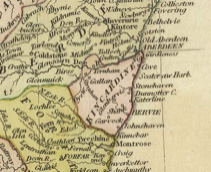
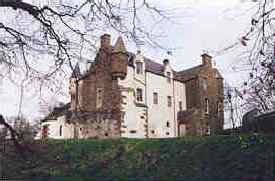
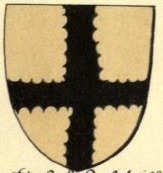
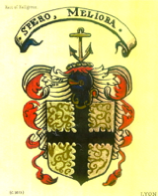
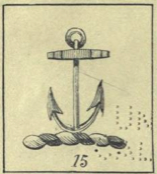
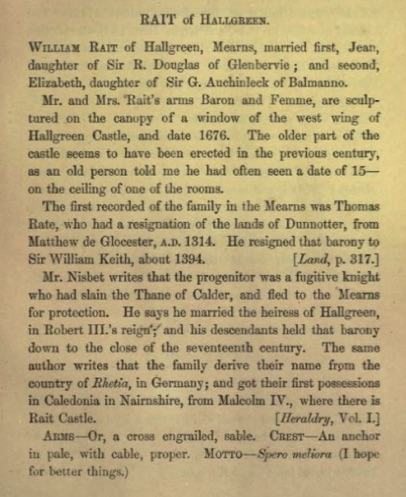
In the Baronage of Angus and The Mearns by David MacGregor Peter published in 1856 there is the entry below (see also under Raitt Name).
(Compiled largely by Lindsay Raitt primarily from the detailed catalogue of the Rait papers in the National Archives of Scotland, and from 19th and 20th century publications.)
Introduction
After the disruption caused by the murder of Andrew Calder, 4th Thane of Cawdor in 1405, by Sir Alexander de Raite (Rathe), and the subsequent flight of the de Rathe family from Moray to Kincardineshire and the protection of the Earl Marischal, there followed a period of resettlement on lands in “The Mearns”. At this time, if not a little earlier, the family dropped the “de Rathe” property-based surname, in favour of “de Rait”, and fairly soon, just plain “Rait”.
The sequence of the primary inheritance line for the next three hundred years, the Raits of Hallgreen, has been well-known since the 19th century, laid out in the volumes of Burke's Landed Gentry of Great Britain and Ireland, and similar publications. Church records, local histories, and particularly access to hundreds of letters and legal documents, such as sasines (land title-deeds), marriage contracts, and sheriff court actions, forming the Rait collection in the National Archives of Scotland, now allow us to amplify that main trunk of our family tree. It seems probable that all families bearing the name Rait or Raitt in the 21st century are descended from one or other of the branches of the Hallgreen tree, though just when and where the branching occurred is may be difficult to identify.
This story covers three hundred years from 1425-1725, during which eleven generations of the Rait family owned Hallgreen Castle at Inverbervie, Kincardineshire. Information about the first four generations is scanty, and perhaps unreliable; thereafter, documented sources provide a more, but not totally, complete picture. Ten of the eleven generations of Hallgreen Rait lairds, other than the first, were alternately called either William or David, and for convenience I have referred to them by the number of their generation. Also, in the absence of records of most births, marriages and deaths, the assignment of the many offspring to a particular generation, and to a particular seniority within the generation is sometimes subjective or uncertain - thus there is scope for future changes to the text which follows.
The Historical Perspective
During the 15th century, the Raits of Hallgreen established themselves as well-connected property owners within the farming-based community of the Mearns, marrying into the neighbouring property-owning families. By the beginning of the 16th century a reversion to their military past seems to have emerged, with William, the third laird, becoming the captain of the King's Guard (James IV) and presumably dying at the Battle of Flodden in 1513, while his grandson, William the fifth laird, is said to have died at the Battle of Pinkie in 1547. In the late 16th century and through the 17th century, the focus of the family's affairs seems to have been fixed on the acquisition of more lands to support the ever-expanding family, with younger sons being directed towards ministry in the Church or being given lands elsewhere in Kincardineshire and into Forfarshire (Angus). Some traded as merchants, which led to Raits becoming bailies of Inverbervie and Dundee, provosts of Montrose and burgesses in Montrose and Aberdeen. Meanwhile, many of the daughters married the sons of neighbouring magnates.
By the second half of the 17th century, the Hallgreen Raits owned extensive lands across these two counties, but a combination of unfortunate circumstances led to a crash in the family fortunes towards the end of the century. The influences which can easily be identified are: the large size of the laird's family to be supported during their early years (peaking in the 20 children of the ninth laird), the allocation of some of the lands to junior members of the family, the ever-increasing number of widows and spinster daughters given support by life-rent bonds, the catastrophic collapse of income of the farming community caused by the disastrous weather conditions in the 1690s which resulted in starvation and the death of a significant proportion of the population of north-east Scotland, and last, but not least, the effect on the finances of Scots families of the collapse of “The Darien Project”, Scotland's equivalent of The South Sea Bubble, which led eventually to the 1705 Union of the Scottish and English Parliaments.
The result of all these problems was that the Hallgreen lands became heavily mortgaged, and in the early years of the 18th century the laird's creditors began proceedings to regain their loans. By 1725, and after the death of the eleventh laird, the remaining property could not sustain the family in Hallgreen Castle which was taken over by the primary remaining creditor. The inheritance of the family lairdship passed from the childless eleventh laird to his brother, Dr George Rait of Dundee who was sufficiently financially independent to purchase the property of Anniston House, south of Montrose, beginning the dynasty of the Raits of Anniston, the primary trunk of the family through the 19th century.
The same Nisbet, mentioned above, in his remarks on the Ragman Roll in his System of Heraldy, states that Gervasius de Rate is the ancestor of the Raits of Halgreen, which is reputed an ancient family in the Merns.
